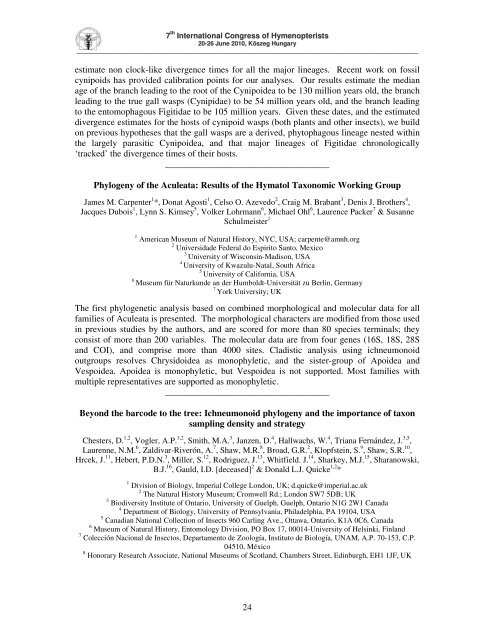Seventh International Congress of Hymenopterists
Seventh International Congress of Hymenopterists
Seventh International Congress of Hymenopterists
Create successful ePaper yourself
Turn your PDF publications into a flip-book with our unique Google optimized e-Paper software.
7 th <strong>International</strong> <strong>Congress</strong> <strong>of</strong> <strong>Hymenopterists</strong><br />
20-26 June 2010, Kszeg Hungary<br />
_____________________________________________________________________________________________________<br />
estimate non clock-like divergence times for all the major lineages. Recent work on fossil<br />
cynipoids has provided calibration points for our analyses. Our results estimate the median<br />
age <strong>of</strong> the branch leading to the root <strong>of</strong> the Cynipoidea to be 130 million years old, the branch<br />
leading to the true gall wasps (Cynipidae) to be 54 million years old, and the branch leading<br />
to the entomophagous Figitidae to be 105 million years. Given these dates, and the estimated<br />
divergence estimates for the hosts <strong>of</strong> cynipoid wasps (both plants and other insects), we build<br />
on previous hypotheses that the gall wasps are a derived, phytophagous lineage nested within<br />
the largely parasitic Cynipoidea, and that major lineages <strong>of</strong> Figitidae chronologically<br />
‘tracked’ the divergence times <strong>of</strong> their hosts.<br />
____________________________________<br />
Phylogeny <strong>of</strong> the Aculeata: Results <strong>of</strong> the Hymatol Taxonomic Working Group<br />
James M. Carpenter 1 *, Donat Agosti 1 , Celso O. Azevedo 2 , Craig M. Brabant 3 , Denis J. Brothers 4 ,<br />
Jacques Dubois 1 , Lynn S. Kimsey 5 , Volker Lohrmann 6 , Michael Ohl 6 , Laurence Packer 7 & Susanne<br />
Schulmeister 1<br />
1 American Museum <strong>of</strong> Natural History, NYC, USA; carpente@amnh.org<br />
2 Universidade Federal do Espirito Santo, Mexico<br />
3 University <strong>of</strong> Wisconsin-Madison, USA<br />
4 University <strong>of</strong> Kwazulu-Natal, South Africa<br />
5 University <strong>of</strong> California, USA<br />
6 Museum für Naturkunde an der Humboldt-Universität zu Berlin, Germany<br />
7 York University; UK<br />
The first phylogenetic analysis based on combined morphological and molecular data for all<br />
families <strong>of</strong> Aculeata is presented. The morphological characters are modified from those used<br />
in previous studies by the authors, and are scored for more than 80 species terminals; they<br />
consist <strong>of</strong> more than 200 variables. The molecular data are from four genes (16S, 18S, 28S<br />
and COI), and comprise more than 4000 sites. Cladistic analysis using ichneumonoid<br />
outgroups resolves Chrysidoidea as monophyletic, and the sister-group <strong>of</strong> Apoidea and<br />
Vespoidea. Apoidea is monophyletic, but Vespoidea is not supported. Most families with<br />
multiple representatives are supported as monophyletic.<br />
____________________________________<br />
Beyond the barcode to the tree: Ichneumonoid phylogeny and the importance <strong>of</strong> taxon<br />
sampling density and strategy<br />
Chesters, D. 1,2 , Vogler, A.P. 1,2 , Smith, M.A. 3 , Janzen, D. 4 , Hallwachs, W. 4 , Triana Fernández, J. 3,5 ,<br />
Laurenne, N.M. 6 , Zaldivar-Riverón, A. 7 , Shaw, M.R. 8 , Broad, G.R. 2 , Klopfstein, S. 9 , Shaw, S.R. 10 ,<br />
Hrcek, J. 11 , Hebert, P.D.N. 3 , Miller, S. 12 , Rodriguez, J. 13 , Whitfield. J. 14 , Sharkey, M.J. 15 , Sharanowski,<br />
B.J. 16 , Gauld, I.D. [deceased] 2 & Donald L.J. Quicke 1,2 *<br />
1 Division <strong>of</strong> Biology, Imperial College London, UK; d.quicke@imperial.ac.uk<br />
2 The Natural History Museum; Cromwell Rd.; London SW7 5DB; UK<br />
3 Biodiversity Institute <strong>of</strong> Ontario, University <strong>of</strong> Guelph, Guelph, Ontario N1G 2W1 Canada<br />
4 Department <strong>of</strong> Biology, University <strong>of</strong> Pennsylvania, Philadelphia, PA 19104, USA<br />
5 Canadian National Collection <strong>of</strong> Insects 960 Carling Ave., Ottawa, Ontario, K1A 0C6, Canada<br />
6 Museum <strong>of</strong> Natural History, Entomology Division, PO Box 17, 00014-University <strong>of</strong> Helsinki, Finland<br />
7 Colección Nacional de Insectos, Departamento de Zoología, Instituto de Biología, UNAM, A.P. 70-153, C.P.<br />
04510, México<br />
8 Honorary Research Associate, National Museums <strong>of</strong> Scotland, Chambers Street, Edinburgh, EH1 1JF, UK<br />
24


